POMONAG: Pareto-Optimal Many-Objective Neural Architecture Generator
Paper and Code
Sep 30, 2024



Neural Architecture Search (NAS) automates neural network design, reducing dependence on human expertise. While NAS methods are computationally intensive and dataset-specific, auxiliary predictors reduce the models needing training, decreasing search time. This strategy is used to generate architectures satisfying multiple computational constraints. Recently, Transferable NAS has emerged, generalizing the search process from dataset-dependent to task-dependent. In this field, DiffusionNAG is a state-of-the-art method. This diffusion-based approach streamlines computation, generating architectures optimized for accuracy on unseen datasets without further adaptation. However, by focusing solely on accuracy, DiffusionNAG overlooks other crucial objectives like model complexity, computational efficiency, and inference latency -- factors essential for deploying models in resource-constrained environments. This paper introduces the Pareto-Optimal Many-Objective Neural Architecture Generator (POMONAG), extending DiffusionNAG via a many-objective diffusion process. POMONAG simultaneously considers accuracy, number of parameters, multiply-accumulate operations (MACs), and inference latency. It integrates Performance Predictor models to estimate these metrics and guide diffusion gradients. POMONAG's optimization is enhanced by expanding its training Meta-Dataset, applying Pareto Front Filtering, and refining embeddings for conditional generation. These enhancements enable POMONAG to generate Pareto-optimal architectures that outperform the previous state-of-the-art in performance and efficiency. Results were validated on two search spaces -- NASBench201 and MobileNetV3 -- and evaluated across 15 image classification datasets.
 Add to Chrome
Add to Chrome Add to Firefox
Add to Firefox Add to Edge
Add to Edge